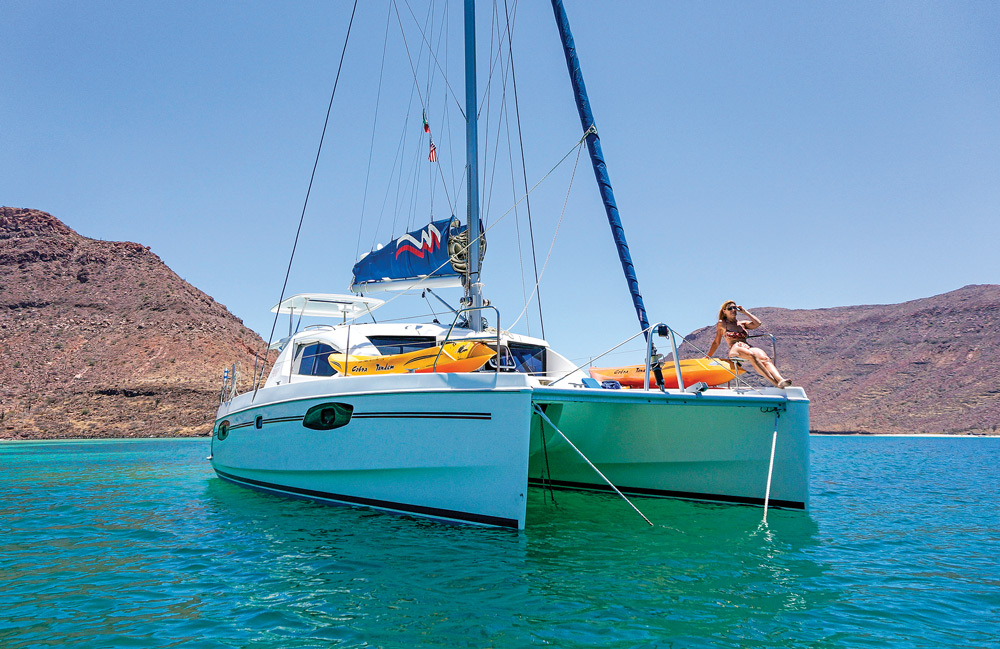Anchoring and mooring a catamaran
Life in an anchorage is great on two hulls so long as you know how to moor the boat
Picking up a mooring
In many cruising destinations, picking up a mooring is the way to go and often the only option in more popular anchorages. On a catamaran a mooring is both a blessing—those that are maintained are securely set, and adequate space between boats isn’t an issue—and a curse, because picking up a mooring from a large cruising catamaran is often more challenging than setting an anchor.
With its high freeboard, grabbing a mooring with a boat hook is an exercise in flexibility, steadiness and aim, that is made more difficult by the amount of distance between the person on the bow and the helmsman. Sit in any well-traveled cruising ground anchorage and you’ll see any manner of methods to pick up a mooring, some more successful than others. In one memorable case a father urged his teenage son to jump in the water to help facilitate picking up the mooring. It will come as no surprise that this is not a recommended method.
The approach for a mooring is the same as anchoring: Come up to the mooring ball from downwind, maintaining a slow speed, but enough to keep the bows pointing into the wind. Obviously the more wind, the more speed you’ll need. Also keep in mind current and the tide, which can complicate the steering duties. Aim to have the mooring ball halfway between the headstay and one of the hulls.

Using two docklines attached to cleats at each bow with a bowline or loop, lead one dockline through the mooring ball line, making sure to lead the dockline outside and under the front lifelines, then take the line back to the cleat it came from and cleat it. Repeat this process with the second dockline, creating a bridle.
With the lines secured through the mooring ball, remove the line from the temporary cleat and ease it into the water, allowing the boat to float downwind. Once the bridle lines are carrying the load of the boat, you can adjust the length as needed to create a Y-shaped setup.
If no center cleat is available to temporarily hold the mooring line while you rig the bridle, a second person can quickly rig one of the bridle lines while the helmsman uses tiny throttle nudges to hold the boat on station so the mooring line doesn’t get ripped out of the crew’s hands. Set one dockline completely before rigging the second.
Not every mooring ball will have a perfect painter. If you come across a painter that is too long it may be impossible to make the bridle short enough. Offshore Sailing School’s Caribbean Manager Folkert “Dutch” Jongkind suggests running bridal lines through an eye on the mooring ball and bypassing the painter all together. This same trick can be used if the painter is in questionable condition.
Communication
Communication is crucial to any anchoring or mooring situation, but it can be even more challenging on a catamaran, where there may be obstructions between the bow and the helm that impede two-way conversation or vision. Because of this it’s important to work out a few hand signals and let the bow crew know what information the helmsman needs to know.
Direction to the anchor or mooring ball can be imparted by pointing your arm or the boat hook at it. Distance in boatlengths can be demonstrated by holding up the appropriate number of fingers. A direction to stop can be shown with a raised fist.
Other signals can be worked out as needed, perhaps one indicating the need for the helmsman to slow down or keep moving forward. This doesn’t have to be a universal language; as long as the person on the bow and the person on the helm know what is being communicated, it will work.
Two-way radio headsets work well for catamaran owners seeking an easy solution to the communication issue, but hand signals should get the job done when chartering.
However, you communicate, having a system to get it done will make mooring a much more pleasant experience, for both your crew and the rest of the anchorage.

Comments